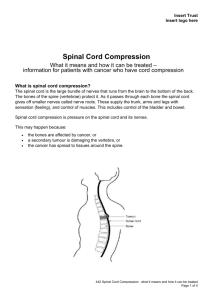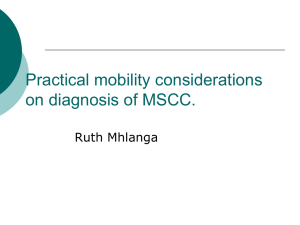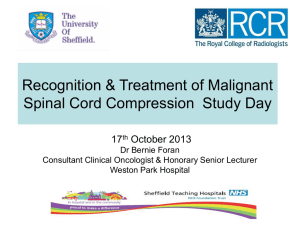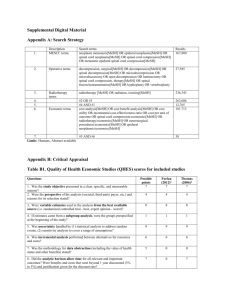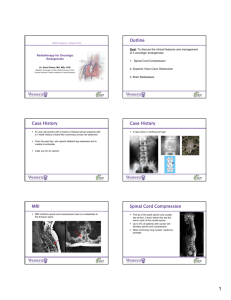information leaflet for patients with suspected malignant spinal cord
advertisement
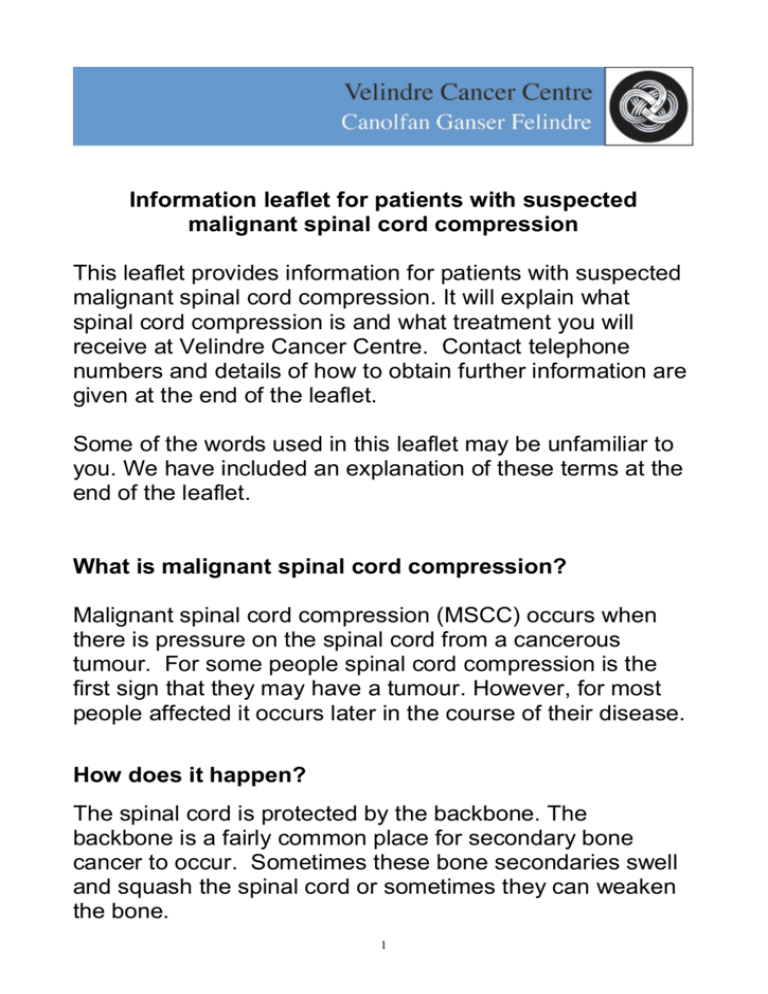
Information leaflet for patients with suspected malignant spinal cord compression This leaflet provides information for patients with suspected malignant spinal cord compression. It will explain what spinal cord compression is and what treatment you will receive at Velindre Cancer Centre. Contact telephone numbers and details of how to obtain further information are given at the end of the leaflet. Some of the words used in this leaflet may be unfamiliar to you. We have included an explanation of these terms at the end of the leaflet. What is malignant spinal cord compression? Malignant spinal cord compression (MSCC) occurs when there is pressure on the spinal cord from a cancerous tumour. For some people spinal cord compression is the first sign that they may have a tumour. However, for most people affected it occurs later in the course of their disease. How does it happen? The spinal cord is protected by the backbone. The backbone is a fairly common place for secondary bone cancer to occur. Sometimes these bone secondaries swell and squash the spinal cord or sometimes they can weaken the bone. 1 What symptoms will I have? The spinal cord acts as a messenger for the brain, telling your arms and legs to move and sending messages back to the brain. In most people the symptoms occur in the lower half of the body, but some people may also be affected in parts of the upper body including the neck and arms. Symptoms vary but may include: Pain Tingling / numbness Heaviness / weakness / paralysis Difficulty in passing urine or a bowel motion What treatment will I have? If your doctor suspects that you have cord compression you will probably be asked to stay in bed, lying as flat as possible. This is very important because this is the safest and most supportive position for your spine. You may also be asked to wear a supportive collar if your neck is affected. If your doctor considers your spine to be stable you will be able to sit up. If this causes pain please inform a doctor or nurse immediately. You may be given tablets to take called Steroids. These will reduce swelling in the area of your spine that is affected. You may be sent for a special scan called an MRI scan. This allows your doctor to have a clear picture of your spine and shows where the problem is. If the scan confirms cord compression it will help to plan your treatment, which may include radiotherapy. 2 What will happen if I need radiotherapy? Your treatment will start with your doctor planning which area of your spine needs radiotherapy. This will happen in Radiotherapy Planning or ‘Marking Up’. Two porters will take you to Marking Up on a trolley. In Marking Up you will be transferred from the trolley on to a hard couch. Usually you will need to lie still on your back whilst your treatment is planned. The doctor and radiographer will be with you and will explain what they are going to do. You will receive between 1 and 10 doses of radiotherapy (1 dose per day). Radiotherapy is painless and usually takes less than 10 minutes per day. During your course of radiotherapy you will see your doctor and physiotherapist on the ward. They will decide when you can start to sit up. Will I need surgery? Surgery may be considered for some people as part of their treatment, for instance when this is the first sign of cancer. In this case you will need to be transferred to another hospital under the care of a specialist surgeon. What help is available whilst I’m at Velindre? Whilst you are on the ward nurses will be available to help you with: Feeding Washing 3 Toileting (some people may need to have a catheter to help them pass water) You will also see a Physiotherapist who will look at your mobility and set goals with you to help you become as independent as possible. You may see a Social Worker and Occupational Therapist who will talk to you and your family about plans for your discharge. This may include advice on any benefits you may be entitled to. You may also be referred to the Cancer Care Cymru Specialist Nurse (Supportive Care) who can provide information, advice and support to help you and your family. What can I expect after my treatment has finished? MSCC affects each person differently. Following treatment, some people with weak legs need to use a stick, walking frame or wheelchair to keep their independence. Other people are able to walk without any assistance. The physiotherapist and nurses will work with you to help you become as independent as possible. Could MSCC happen again? Yes, unfortunately in some people MSCC can happen again. Sometimes a different part of the spine can be affected. If the symptoms mentioned above come back or suddenly get worse you will need to contact you GP immediately. 4 Glossary Catheter – A small thin flexible tube which drains urine away from the bladder into a plastic collection bag which can be emptied as required. Malignant – This is a cancer with the potential to spread to other parts of the body. Marking Up - A room in the hospital containing special machines where your radiotherapy treatment is planned. Marking Up is also known as simulator or planning. MRI Scan – (Magnetic Resonance Imaging) This is a special type of scan. A separate information leaflet is available. Paralysis – Loss of power or sensation in any part of the body. Radiotherapy – This is the use of high-energy X-rays to treat cancer. Secondaries – If cancer has spread to another part of the body then it is described as secondaries. 5 Contact telephone numbers Further information and advice is available from: Physiotherapy department 029 2061 5888 ext 6340 Cancer Care Cymru 029 2054 6670 Cancerbackup www.cancerbackup.org.uk 0808 800 1234 Macmillan www.macmillan.org.uk 0808 808 2020 Tenovus www.tenovus.com 0808 808 1010 6 Velindre Cancer Centre Velindre Road Whitchurch Cardiff CF14 2TL Phone: 029 2061 5888 7 This information leaflet has been written by health professionals. Sources of information include the expert opinion of medical and physiotherapy staff at Velindre Cancer Centre and the opinion of people who have experienced MSCC. A medical text referred to is DeVita V.T et al (1997) Cancer principles and practice of oncology (5th edition) published by Lippincot and Raven. The leaflet has been approved by a team of doctors, nurses and patients. It is reviewed and updated annually. Prepared December 2002 Reviewed September 2007 by Dr Nikki Pease, Physiotherapist & Cancer Care Cymru Specialist Nurse (Supportive Care) 8



